Complex Story? Use a Crime Wall — Guest: Kitty The Retro-Writer
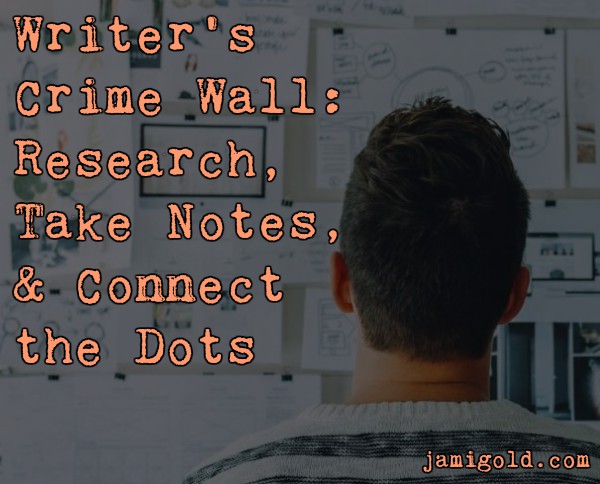
When we’re drafting or editing our story, we usually have to keep track of many, many threads. Who knows what, who’s keeping secrets, where is everyone in each scene, etc., etc.
Add in all our research and the types of details that might later go into a story bible—like characters’ appearances, background, and setting information—and pulling the pieces of a story together can be a complicated job. The difficulty skyrockets if our story is complex, with lots of characters, secrets, mysteries, parallel plots, etc.
What’s an overwhelmed writer to do? Some of us keep track in notebooks or systems like OneNote, but other writers—or more complex stories—need a bit more. *grin*
Today, Kitty The Retro-Writer—who uses a non-traditional pen name because she loves the idea of having a secret identity—is sharing her expertise as a noir mystery author who needs to keep track of countless clues. She’s teaching us how to stay on top of our story and its details with a crime wall.
Please welcome Kitty The Retro-Writer! *smile*
*****
The Writer’s Crime Wall
By Kitty The Retro-Writer
Do you have trouble keeping your novel’s information straight in your head despite the elaborate organizational system you have on your computer? Have you ever wondered how detectives and investigators keep their facts straight during an investigation?
Let’s study the true crime detective’s most essential tool: the Crime Wall.
By applying the same technique with our writing, we can create a well-defined writing space that will help us better connect with our story and our characters, thereby deepening our plot and creating a sense of realism.
What is a Crime Wall?
A Crime Wall is an extensive space (usually several whiteboards or corkboards grouped together) covered with facts, notes, maps, interrogations, and photos of people, places, and evidence—all placed together on a wall. Much like a Mind Map, a Crime Wall strings together and organizes evidence, linking together all possible connections.
Would a Writer's Crime Wall help organize your complex story? Find out with @atwistofnoir... Click To TweetPerhaps you have seen an elaborate Crime Wall created for a television detective’s investigation. My favorite example of a Crime Wall (also known as a Crazy Wall, Conspiracy Wall, and Murder Wall) was beautifully displayed in the crime-writing comedy, Castle, starring Nathan Fillion.
The moment I saw his gorgeous wall, I was instantly shot through with envy. Fast forward a few years, and I have set about creating a more user-friendly (and old-school) Crime Wall for my newest short-story series.
(Note from Jami: Click on the images in this post to view as a larger size. Newsletter readers: Click through to the post to see the examples.)
What goes on a Writer’s Crime Wall?
A Writer’s Crime Wall differs somewhat in detail compared to a true detective’s wall. A Writer’s Crime Wall will include all things relevant to the story being written.
Because I am an avid fan of detective fiction, I like to make things as fictionally realistic as possible. Therefore, my wall has:
- Character Sketches – including excerpts from interviews with my characters, and photos drawn from my favorite artist on Fiverr
- Relevant Newspaper Clippings for reference
- Picture & Maps of areas I am writing about
- Symbols, Accessories, etc. included in story
- Corresponding Notes Post-Its
- Timelines
- Story’s Social Structures
The Crime Wall is great for any writer, but especially for the Sci-fi, Adventure, and Fantasy genres that need to keep well-organized and structured.
We can include elements such as:
- Magic Systems & Limitations
- Timelines
- World Building
- Social Structures
Piecing It All Together
Generally, I use four boards:
Board #1: Character Study
On the Character Study board, we’ll place the photos of our characters and the most relevant information from our character dossiers.
Board #2: Character Mind Map
This board connects all of the characters together, creating a plot map to return to if I get lost, confused, or stuck. The Character Mind Map board is all about the characters and how they relate to the story. I like to place my main characters in the middle, then fan out my other characters that are most pivotal to the story, noting who they are and why the matter in my book.
Board #3: Clue Board
The third board is somewhat connected to the second board, often overlapping; it may or may not have push-pins connecting color coordinated strings to the second board. This board connects everything together with maps, notes, post-its, and visual cues for me to use as triggers. It also holds newspaper clippings, any symbols I may be including in the story or series, etc.
Here’s an example from Sherlock:
Board #4: Beat Sheet/Plot Outline
Being dyslexic, I find that it helps me keep track of everything if it is in a larger print and color-coded. To prevent extra editing in my future drafts, I try to keep my writing as close to my beat sheet as possible. It is much easier to keep everything well-organized in my mind if I see it large as life on my board.
Other Possible Boards: Research, Inspiration, Settings, Etc.
My newest series is based in the nineteen-thirties. Because I am such a stickler for historical accuracy, I have created a special board specifically for my time-period.
On it, I keep anything that is directly related to the thirties—from hairstyles to specific wardrobe colors and fashions for every season. I place the names of the types of hats, clothes, and my favorite slang words from that period or sayings that I will want to have readily available. I also like to place old newspaper clippings and even pieces of cloth along with anything else that I may use to trigger textural inspiration.
Where To Start?
When writing a story, I like to start with a basic idea of what is going to happen, then focus on developing my characters. Without our characters, there is no story.
- As I interview my characters, the story emerges and fleshes out. My character interviews are rather extensive, so I only place the most relevant information on my wall. The rest, I keep within easy reach in a folder that looks similar to the Character Study Board on my Crime Wall.
Once all of the information is written down, and the character picture is placed beside or above the character information, I move on to the next board. - The Character Mind Map Board connects all of my characters and information similar to a mind map using circles, squares, or rectangles to hold the concentrated version of data for quick reference, along with pictures of characters.
- On the Clue Board, I place essential information to the story or series: newspaper clippings that will help inspire me through possible blocks, maps of the area I am writing about (if your area is fictitious, you can hire a cartographer on Fiverr to draw them for you), plus any notes and facts that arise in the writing process. I also include drawings or photos of any symbols, accessories or tools used as plot propellants or red-herrings.
- On my final board is the larger version of my Beat Sheet and my Plot Outline. This board holds my beat sheet on the upper part of the board and my plot outline on the lower part of the board. Depending on the length of my plot/beat sheet, I will separate the two sections with colored masking tape.
How To Use The Crime Wall?
Once my Crime Wall is “complete” (when is it ever complete? I continuously add things to it as my books develop), I have an extensive overview of my book or series. It is a point of reference, and most importantly, an anchor to the world I have created.
Learn how to set up a Writer's Crime Wall to organize our story with @atwistofnoir Click To TweetThe beauty of a Crime Wall is, no matter how chaotic and insane my world gets, I can fall into my story and characters without a struggle. If I get stuck or accidentally veer off the plot’s course, I have all of the information large as life in front of me to help get me back on track and immerse me in my book’s world.
Another positive aspect of the Crime Wall is being able to make drastic changes to your plot without having to go back to a spreadsheet to adjust. Just wipe it off or move it around to make your tweaks, and continue writing!
If you are having trouble keeping all of your character and plot information straight, try creating your own Crime Wall. Have you built a Crime Wall or have fun ideas for variations? Please share your thoughts or ideas in the comments below!
*****
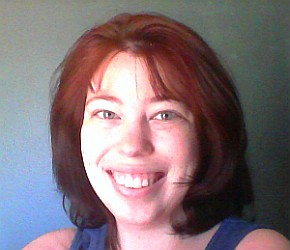 Hello! (happy waves!)
Hello! (happy waves!)
I am “Kitty” AKA Retro-Writer, Authoress of mystery and sweet romance, with a Twist of Noir. I am a novelist, reviewer, & book doctor.
My favorite part of my job is working with budding authors. My passion is to help new authors find their voice & style, learn their trade, and make a comfortable career out of writing, all by mastering the underlying foundations of writing & technique.
Website | Instagram | Twitter | Patreon
*****
 About Kitty’s Book Doctor Service:
About Kitty’s Book Doctor Service:
As a book doctor, I am serious about helping my clients find the necessary tools & resources and provide them with the help they need to start on their writing path with a solid foundation.
3 things I can do as a Book doctor:
- Help you refine your story: How will your readers react to your story? Have you avoided cliches, stoked rising action, perfected the pace, and built to a spectacular climax?
- Focus on the characters: Are they memorable, appealing, and stand apart? Create characters your readers won’t ever forget.
- Focus on the language: We’ll condense your story and remove the unnecessary excess. (As an ESL Teacher, I also have experience helping writers that are writing in English as a second language.)
*****
Thank you, Kitty! I’m a visual person, so I’ve always found these types of boards fascinating on TV, whether they’re for mysteries/crimes or for conspiracies. I can definitely understand how the visual reference of a Writer Crime Wall would be helpful for our stories.
So far, I’ve kept track of my story details in Microsoft OneNote. I have a folder for each story, and in that folder, I have pages for brainstorming ideas, reference and research links, character and setting information, editing notes, etc.
But for those who want something more tangible, or for stories that need more cross-referencing, a Writer “Crime” Wall could be more flexible—and more fun. *grin*
I like the idea of having our Wall as an anchor to the story as well, helping us pick up all the threads again if we have to take a break to work on another project or focus on non-writing stuff for a while. I’d also be interested to hear if those who have created these Walls before found it easier to write a synopsis, as it might highlight the most important—most connected and relevant—story details to include.
However we write, we need to keep track of our stories details. If our story is complex or if we like visual and/or tangible references, it’s good to add this technique to our toolbox. *smile*
Have you heard of or seen on TV a Crime Wall before? Have you ever created one for yourself or your stories? Did you find it helpful, and if so, how? Do you have any thoughts on variations, other uses or benefits, or other boards we might want for our story? Do you have any questions for Kitty?
Pin It
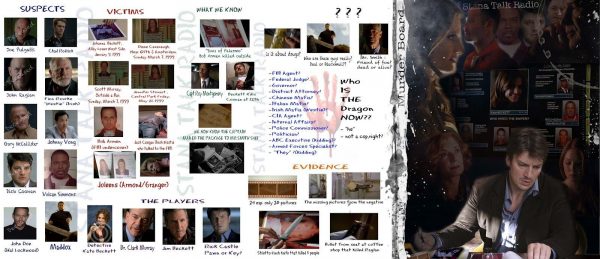

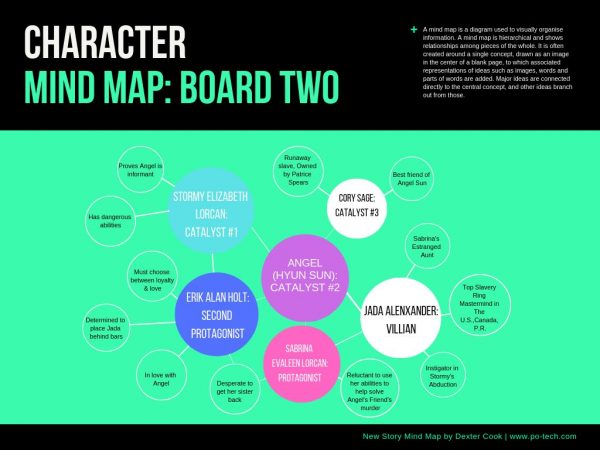

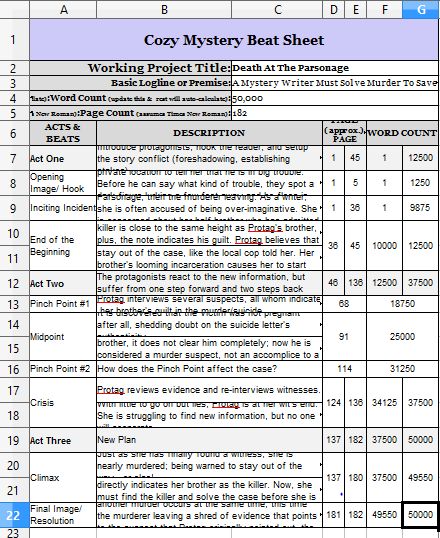
Great post! The idea of creating a place where you can instantly get a bird’s eye view of your story makes perfect sense. And, as you point out, it’s a handy resource when you’ve been away from your desk and need to get back into the imaginary world you’re constructing.
Thank you, Mike! It really helps keep everything fresh and organized in my mind. The crime wall is also great for the tactile writer, who needs to feel what they are writing. 🙂
As someone who shares a small house with a family, this is difficult to put up since we also share rooms. I tried virtual crime boards; helpful for basic stuff, but you have to shell cash for the better stuff. And also, there’s just something about physically writing it that makes the crime wall more fleshed out or something.
So far what I’ve done is a table in Google docs. It works so far in listing the chapter summaries and such, but nothing great like crime walls.
Thanks for writing & posting.
Somebodylost,
I empathize with you! I have shared a tiny space with several people. It wasn’t easy; sacrificing privacy can be quite trying at times! What I did in this situation was create a Crime Wall, using the back of a shared bedroom door. They didn’t mind, and I had my “special writing space” for brainstorming. I wish you the best of luck in your writing! Keep us updated, and most of all, keep writing! 😘
AWESOME POST!! I’m also so visual that this is how I kinda need to “see” my story.. AWESOME!!
Laura,
Thank you for the kind words! I love how well this method of outlining works for us “visuals!” If you try the Crime Wall let us know how it works for you! Happy holidays!
This is a terrific post. Thanks. I will be posting the link on my blog.
Rosi,
Thank you! That is wonderful! How kind of you!
Happy Holidays!
For me, my stories are definitely highly complex (with fantasy and/or sci-fi worlds, and many characters), but I just use two MS word documents to help me organize each book. One word doc is a timeline, where I keep track of which chapters of my story correspond to which dates. (I have to guess a date if it’s never explicitly stated in my story, or if the time passage is only mentioned vaguely, like “After a few days”). My other word doc is my Factfile, where I put in information about my characters, locations, magic systems, historical events, important objects, unanswered questions in my story, things I plan to edit or change later, etc.
But this crime wall idea sounds very neat! Very visual and interconnected. And wow, I never knew you could hire a cartographer to help you draw a map for a fictioal setting!
Sieran,
MSWord documents are definitely a handy tool in the writer’s kit! Thank you for sharing your preferred method of keeping your storyline straight. 🙂
Fiverr is a treasury of creative abilities and services. I highly recommend the website.
[…] There’s a lot of planning that goes into starting a book. Katrina Byrd has 3 approaches to story planning, Stavros Halvatzis tells how to nail your story logline, Ban discusses world-building on the crossroads, and Kitty the Retro-Writer advises using a crime wall to keep track of a complex story. […]